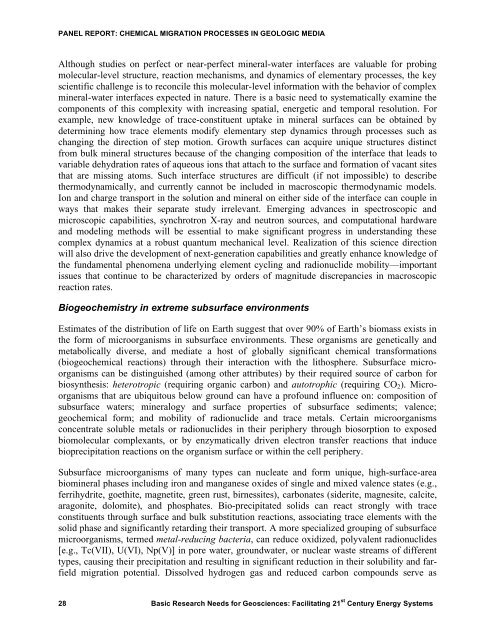Basic Research Needs for Geosciences - Energetics Meetings and ...
Basic Research Needs for Geosciences - Energetics Meetings and ...
Basic Research Needs for Geosciences - Energetics Meetings and ...
- No tags were found...
You also want an ePaper? Increase the reach of your titles
YUMPU automatically turns print PDFs into web optimized ePapers that Google loves.
PANEL REPORT: CHEMICAL MIGRATION PROCESSES IN GEOLOGIC MEDIAAlthough studies on perfect or near-perfect mineral-water interfaces are valuable <strong>for</strong> probingmolecular-level structure, reaction mechanisms, <strong>and</strong> dynamics of elementary processes, the keyscientific challenge is to reconcile this molecular-level in<strong>for</strong>mation with the behavior of complexmineral-water interfaces expected in nature. There is a basic need to systematically examine thecomponents of this complexity with increasing spatial, energetic <strong>and</strong> temporal resolution. Forexample, new knowledge of trace-constituent uptake in mineral surfaces can be obtained bydetermining how trace elements modify elementary step dynamics through processes such aschanging the direction of step motion. Growth surfaces can acquire unique structures distinctfrom bulk mineral structures because of the changing composition of the interface that leads tovariable dehydration rates of aqueous ions that attach to the surface <strong>and</strong> <strong>for</strong>mation of vacant sitesthat are missing atoms. Such interface structures are difficult (if not impossible) to describethermodynamically, <strong>and</strong> currently cannot be included in macroscopic thermodynamic models.Ion <strong>and</strong> charge transport in the solution <strong>and</strong> mineral on either side of the interface can couple inways that makes their separate study irrelevant. Emerging advances in spectroscopic <strong>and</strong>microscopic capabilities, synchrotron X-ray <strong>and</strong> neutron sources, <strong>and</strong> computational hardware<strong>and</strong> modeling methods will be essential to make significant progress in underst<strong>and</strong>ing thesecomplex dynamics at a robust quantum mechanical level. Realization of this science directionwill also drive the development of next-generation capabilities <strong>and</strong> greatly enhance knowledge ofthe fundamental phenomena underlying element cycling <strong>and</strong> radionuclide mobility—importantissues that continue to be characterized by orders of magnitude discrepancies in macroscopicreaction rates.Biogeochemistry in extreme subsurface environmentsEstimates of the distribution of life on Earth suggest that over 90% of Earth’s biomass exists inthe <strong>for</strong>m of microorganisms in subsurface environments. These organisms are genetically <strong>and</strong>metabolically diverse, <strong>and</strong> mediate a host of globally significant chemical trans<strong>for</strong>mations(biogeochemical reactions) through their interaction with the lithosphere. Subsurface microorganismscan be distinguished (among other attributes) by their required source of carbon <strong>for</strong>biosynthesis: heterotropic (requiring organic carbon) <strong>and</strong> autotrophic (requiring CO 2 ). Microorganismsthat are ubiquitous below ground can have a profound influence on: composition ofsubsurface waters; mineralogy <strong>and</strong> surface properties of subsurface sediments; valence;geochemical <strong>for</strong>m; <strong>and</strong> mobility of radionuclide <strong>and</strong> trace metals. Certain microorganismsconcentrate soluble metals or radionuclides in their periphery through biosorption to exposedbiomolecular complexants, or by enzymatically driven electron transfer reactions that inducebioprecipitation reactions on the organism surface or within the cell periphery.Subsurface microorganisms of many types can nucleate <strong>and</strong> <strong>for</strong>m unique, high-surface-areabiomineral phases including iron <strong>and</strong> manganese oxides of single <strong>and</strong> mixed valence states (e.g.,ferrihydrite, goethite, magnetite, green rust, birnessites), carbonates (siderite, magnesite, calcite,aragonite, dolomite), <strong>and</strong> phosphates. Bio-precipitated solids can react strongly with traceconstituents through surface <strong>and</strong> bulk substitution reactions, associating trace elements with thesolid phase <strong>and</strong> significantly retarding their transport. A more specialized grouping of subsurfacemicroorganisms, termed metal-reducing bacteria, can reduce oxidized, polyvalent radionuclides[e.g., Tc(VII), U(VI), Np(V)] in pore water, groundwater, or nuclear waste streams of differenttypes, causing their precipitation <strong>and</strong> resulting in significant reduction in their solubility <strong>and</strong> farfieldmigration potential. Dissolved hydrogen gas <strong>and</strong> reduced carbon compounds serve as28 <strong>Basic</strong> <strong>Research</strong> <strong>Needs</strong> <strong>for</strong> <strong>Geosciences</strong>: Facilitating 21 st Century Energy Systems
















